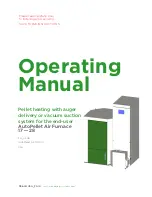
© 2021 Carrier. All rights reserved.
A Carrier Company
Edition Date: 12/21
Catalog No: IM-CNPH-13
Replaces: IM-CNPH-12
CNPHP: Installation Instructions
Manufacturer reserves the right to change, at any time, specifications and designs without notice and without obligations.
6
8. After brazing, allow joints to cool. Carefully remove TXV bulb
insulation and verify that the TXV bulb is securely fastened with
hose clamp. Tighten screw a half-turn past hand tight with TXV
bulb placed in the indentation with full contact with the vapor line
tube. Re-wrap TXV bulb with insulation.
9. Leak check connections before insulating entire suction line.
10. Slide tubing plate with rubber grommets over joints. Position
tubing at center of each grommet to ensure an air seal around the
tube. Reinstall cabinet door.
CONDENSATE DRAIN LINE CONNECTION
The coil is designed to dispose of accumulated water through built-in
condensate drain fittings. It is recommended that PVC fittings be used
on the condensate pan. Do not over-tighten. Finger tighten plus 1-1/2
turns. Be sure to install plastic plug in unused condensate drain fitting.
Two 3/4-in. female threaded pipe connections are provided in each coil
condensate pan.
A trap is not necessary on the condensate line. Consult local codes for
additional restrictions or precautions. If local codes require a trap then
the following guidelines are suggested to assure proper drainage. Install
a trap in condensate line of coil as close to the coil as possible. Make trap
at least 3 in. (76 mm) deep and no higher than the bottom of unit
condensate drain opening (
). Pitch condensate line 1 in. (25.4 mm)
for every 10 ft. of length to an open drain or sump. Make sure that the
outlet of each trap is below its connection to condensate pan to prevent
condensate from overflowing the drain pan. Prime all traps, test for
leaks, and insulate traps and lines if located above a living area.
A08067
Fig. 8 – Condensate Trap
NOTE:
If unit is located in or above a living space, where damage may
result from condensate overflow, a field-supplied, external condensate
pan should be installed underneath the entire unit, and a secondary
condensate line (with appropriate trap) should be run from the unit into
the pan. Any condensate in this external condensate pan should be
drained to a noticeable place. As an alternative to using an external
condensate pan, some localities may allow the running of a separate
3/4-in. (19 mm) condensate line (with appropriate trap) per local code to
a place where the condensate will be noticeable. The owner of the
structure must be informed that when condensate flows from secondary
drain or external condensate pan, the unit requires servicing or water
damage will occur. To further protect against water damage, install a
float switch to shut the unit off if the water in the secondary pan gets too
high.
NOTE:
To avoid drainage problems, test the primary drain line by
slowly pouring water into the pan. Check piping for leaks and proper
condensate drainage. Using the secondary drain as explained in the
previous note provides further protection against overflow due to a
clogged primary drain.
NOTE:
In applications where return air humidity levels stay at 70% or
above for a prolonged period of time, condensation can form on the
bottom of pan and drip.
WASTE LINE CONNECTION
If the condensate line is to be connected to a waste (sewer) line, an open
trap must be installed ahead of the waste line to prevent escape of sewer
gases (
).
A10216
Fig. 9 – Condensate Drain to Waste Line
CARE AND MAINTENANCE
To continue high performance and minimize possible equipment failure,
it is essential that periodic maintenance be performed on this equipment.
Consult your local dealer as to the proper frequency of maintenance, but
it should be done at least annually.
The ability to properly perform maintenance on this equipment requires
certain mechanical skills and tools. If you do not possess these, contact
your dealer for maintenance. The only consumer service recommended
or required is filter replacement or cleaning on a monthly basis.
CAUTION
!
PROPERTY DAMAGE HAZARD
Failure to follow this caution may result in property damage.
When installing over a finished ceiling and/or living area, install a
field-fabricated secondary condensate pan under the entire unit.
3” / 76mm
WARNING
!
EXPLOSION HAZARD
Failure to follow this warning could result in personal injury or death.
Provide trap with air gap in drain line when connecting to waste (sewer)
line.
CAUTION
!
ENVIRONMENTAL HAZARD
Failure to follow this caution may result in environmental damage.
Remove and recycle all components or materials (i.e., oil, refrigerant,
etc.) before unit final disposal.
Condensate
Line
Trap
Sewer Line
Air Gap Above
Liquid Level
























